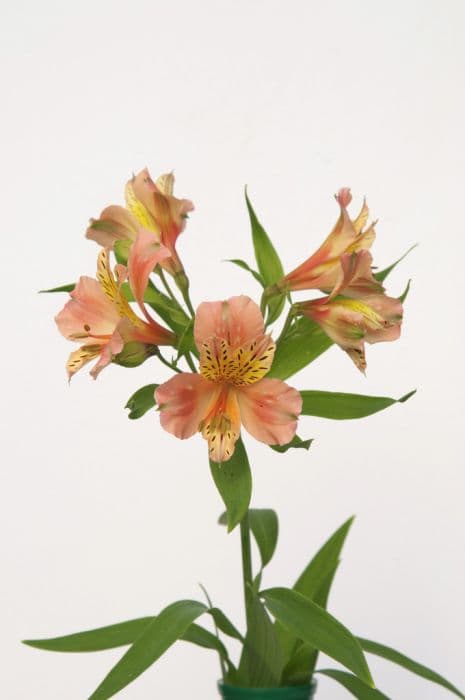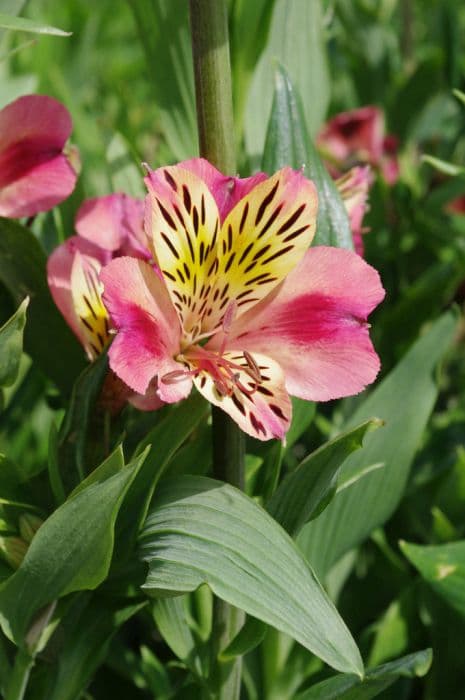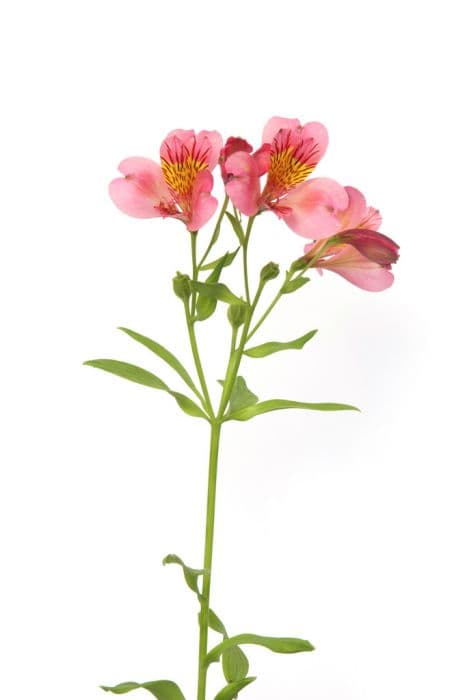Peruvian Lily Alstroemeria Inticancha Imala = 'Tesima' (PBR) (Inticancha Series)
![Peruvian lily [Inticancha Imala]](/_next/image?url=https%3A%2F%2Fplants-admin.emdemapps.com%2Fimages%2Fplants%2F%2Fimages%2F604b619b522ba.png&w=3840&q=75)
ABOUT
The Alstroemeria, also known as the Peruvian Lily or Lily of the Incas, from the Inticancha series, particularly the 'Tesima' variety, is a captivating plant known for its striking and vibrant flowers. The blossoms exhibit a blend of colors, often featuring a mix of pink, peach, or coral hues, with each petal distinctively adorned with darker speckles or streaks that can resemble freckles. These decorative markings add a touch of exotic allure to the already eye-catching blossoms. The flowers of the Inticancha Imala are shaped like miniature lilies, with each petal gracefully curving outward, adding a sense of elegance and texture to the floral display. These blooms are typically arranged in clusters atop slender, upright stems, creating an impressive display of color that can enliven any garden space or serve as a striking cut flower in bouquets. The foliage of this plant consists of lance-shaped leaves that are lush and green, providing a dense backdrop for the bright flowers. The leaves may also exhibit a slight sheen, contributing to the plant's overall visual interest. The contrast between the delicate flowers and the robust foliage creates a harmonious balance in both garden settings and floral compositions.
About this plant
 Names
NamesFamily
Alstroemeriaceae
Synonyms
Peruvian Lily, Lily of the Incas, Parrot Lily
Common names
Alstroemeria Inticancha Imala 'Tesima' (PBR) (Inticancha Series)
 Toxicity
ToxicityTo humans
The Alstroemeria, also known as Peruvian lily or lily of the Incas, is not generally considered toxic to humans. However, like many plants, it may cause mild irritation if ingested, such as nausea or an upset stomach. It's always advisable to avoid eating ornamental plants as a precautionary measure.
To pets
The Peruvian lily is considered non-toxic to cats and dogs by the American Society for the Prevention of Cruelty to Animals (ASPCA). However, ingestion can sometimes result in mild gastrointestinal upset, such as vomiting or diarrhea. If a pet displays symptoms after ingesting plant material, it is best to consult a veterinarian.
 Characteristics
CharacteristicsLife cycle
Perennials
Foliage type
Evergreen
Color of leaves
Green
Flower color
Mixed
Height
1-2 feet (30-60 cm)
Spread
1-2 feet (30-60 cm)
Plant type
Bulb
Hardiness zones
7
Native area
South America
Benefits
 General Benefits
General Benefits- Long Blooming Season: Produces flowers for an extended period, often from late spring through early autumn.
- Colorful Blooms: Offers a vibrant display of colors that can enhance the visual appeal of any garden or arrangement.
- Low Maintenance: Requires minimal care once established, making it a convenient choice for gardeners of all levels.
- Drought Tolerance: Able to withstand periods of dryness once established, reducing the need for frequent watering.
- Attracts Pollinators: Draws in bees and other beneficial insects, which promote pollination of garden plants.
- Cut Flower Longevity: Flowers have a long vase life, making them ideal for bouquets and floral arrangements.
- Compact Growth Habit: The 'Inticancha' series, including this variety, is bred for compact growth, making it suitable for containers and small gardens.
 Medical Properties
Medical PropertiesThis plant is not used for medical purposes.
 Air-purifying Qualities
Air-purifying QualitiesThis plant is not specifically known for air purifying qualities.
 Other Uses
Other Uses- Photography Prop: The vibrant colors of Alstroemeria Inticancha Imala make it a popular choice for photographers looking to add a pop of natural beauty to their portraits or still-life compositions.
- Educational Tool: Botany students and educators may use this plant to study the unique pollination mechanisms and breeding practices in the Alstroemeria genus.
- Wedding Decor: The flowers of the Peruvian Lily can be used in wedding bouquets, centerpieces, or as decorations due to their elegant appearance and longevity after being cut.
- Art Inspiration: Artists may draw inspiration from the intricate patterns and blend of colors on the petals of the Alstroemeria Inticancha Imala for paintings, textile designs, or other artistic creations.
- Crafting: The sturdy stems and colorful blooms are ideal for creating homemade wreaths, garlands, or other craft projects.
- Culinary Garnish: Although not commonly consumed, the flowers might be used as an ornamental and non-toxic garnish for special dishes in high-end culinary presentations.
- Theme Gardens: Garden designers might incorporate Alstroemeria Inticancha Imala in themed gardens that focus on South American plants or those with specific color schemes.
- Cultural Celebrations: This plant could play a role in cultural events or festivals, especially those celebrating Peruvian heritage, where it could be used for decorative purposes.
- Fashion Accessories: Crafters might use the flowers to create unique, natural jewelry such as hairpins, brooches, or pendants.
- Color Dye Source: Although not a traditional use, the pigments in the petals may potentially be used to extract color for natural dyes in small-scale or experimental textile projects.
Interesting Facts
 Feng Shui
Feng ShuiThe Peruvian Lily is not used in Feng Shui practice.
 Zodiac Sign Compitability
Zodiac Sign CompitabilityThe Peruvian Lily is not used in astrology practice.
 Plant Symbolism
Plant Symbolism- Friendship: Alstroemerias, also known as Peruvian Lilies or Lily of the Incas, often symbolize enduring friendships due to their long-lasting nature as cut flowers.
- Devotion: The twisted leaves of the Alstroemeria represent the intertwining of two lives and thus signify mutual support and devotion between individuals.
- Wealth and Prosperity: With their multiple blooms and lush appearance, Peruvian Lilies can evoke a sense of abundance and are sometimes associated with wealth and prosperity.
- Achievement of Personal Aspirations: The diverse and vibrant colors of the Peruvian Lily blossoms are thought to encourage the pursuit and achievement of one's personal goals.
- Fortune: Peruvian Lilies are believed to bring good fortune to those who give or receive them.
 Water
WaterThe Peruvian Lily, commonly known as Alstroemeria, needs consistent moisture, especially during the growing season. Water the plant deeply once a week, allowing the water to penetrate the soil to encourage deep root development. Depending on the weather and soil conditions, this generally means providing about one to two gallons of water per week. During hot spells or if you notice the leaves wilting, increase the frequency but be careful not to waterlog the soil. During the winter months, reduce watering to every other week or when the soil feels dry to the touch, as the plant requires less moisture when not actively growing.
 Light
LightPeruvian Lily thrives in bright, indirect sunlight or partial shade. The best spot for this plant is where it can receive morning sunlight and afternoon shade, protecting it from the intense midday sun. Avoid placing it in full shade as this can reduce flowering; likewise, too much direct sunlight can scorch the leaves and damage the blooms.
 Temperature
TemperatureThe ideal temperature range for the Peruvian Lily is between 65°F to 80°F. They can tolerate a minimum temperature of around 50°F and a maximum of around 90°F. For optimal growth, try to avoid temperatures that drop below the minimum, as frost can damage the plant, and keep it out of excessively hot conditions which can stress the plant and lead to poor blooming.
 Pruning
PruningPrune Peruvian Lily to remove spent flowers and encourage reblooming. Cut back the stems after flowering to stimulate new growth; doing this every few weeks during the blooming season can help maintain a tidy appearance and promote continuous blooms. The best time for pruning is when the flowers start to fade, as this encourages the plant to focus its energy on producing new blooms.
 Cleaning
CleaningAs needed
 Soil
SoilPeruvian Lily 'Tesima' thrives best in a well-draining soil mix composed of equal parts potting soil, peat, and perlite or sand. The optimal soil pH should be slightly acidic to neutral, ranging between 6.0 and 7.0. Regular incorporation of organic matter like compost will enhance soil fertility and structure, contributing to the health and blooming of the plant.
 Repotting
RepottingPeruvian Lily 'Tesima' typically requires repotting every two to three years as it can quickly outgrow its container. It's best to repot in late winter or early spring before the onset of new growth. Choose a container only slightly larger than the previous one to avoid overpotting, which could lead to water retention issues.
 Humidity & Misting
Humidity & MistingPeruvian Lily 'Tesima' prefers moderate humidity levels around 40-60%. While it can tolerate lower humidity, maintaining a steady moderate level will support its health and flowering. Avoid placing it in overly dry or drafty areas as this can stress the plant and cause leaf problems.
 Suitable locations
Suitable locationsIndoor
Bright indirect light, keep moist, feed monthly in growth.
Outdoor
Plant in sun/part shade, shelter from strong winds.
Hardiness zone
7-10 USDA
 Life cycle
Life cycleThe Alstroemeria Inticancha Imala, commonly known as Inca Lily, begins its life as a rhizome, which, once planted, will sprout into a seedling. As it grows, the plant develops a strong stem and foliage, entering a vegetative state where it focuses on leaf growth. During its flowering phase, which can occur multiple times throughout the growing season, the Inca Lily produces a profusion of colorful blooms that are often used for cut flowers. After blooming, if conditions allow, the plant may enter a period of dormancy, particularly in cooler climates, where it rests and conserves energy for the next growing season. With the return of favorable conditions, the Inca Lily exits dormancy, begins a new growth cycle, and can continue this process for several years given proper care. Eventually, as the plant ages, it reaches the end of its life span and will die, but it can produce offspring through its rhizomes or seeds before this stage.
 Propogation
PropogationPropogation time
Spring-Early Summer
Propogation: The Alstroemeria, commonly known as the Peruvian Lily or Lily of the Incas, can be propagated by division, which is the most popular method for multiplying these plants. This technique involves gently separating the rhizomes of an established plant while it is dormant, typically in the fall or early spring. Care must be taken not to damage the roots while dividing the clusters into smaller sections, each with one or two growth points or "eyes." These sections are then replanted into a well-draining soil mix, ideally at the same depth as they were previously growing. Watering should be light until new growth appears, indicating the division has been successful. It is crucial to ensure that the soil remains moist but not waterlogged as the new plants establish themselves.




![Peruvian lily [Indian summer]](/_next/image?url=https%3A%2F%2Fplants-admin.emdemapps.com%2Fimages%2Fplants%2F%2Fimages%2F604b616bc746b.png&w=640&q=75)
![Peruvian lily [Inticancha Creamy Dark Pink]](/_next/image?url=https%3A%2F%2Fplants-admin.emdemapps.com%2Fimages%2Fplants%2F%2Fimages%2F604b5e98bea7c.png&w=640&q=75)
![Peruvian lily [Inticancha Red]](/_next/image?url=https%3A%2F%2Fplants-admin.emdemapps.com%2Fimages%2Fplants%2F%2Fimages%2F604b5aebac273.png&w=640&q=75)
![Peruvian lily [Inticancha Sunday]](/_next/image?url=https%3A%2F%2Fplants-admin.emdemapps.com%2Fimages%2Fplants%2F%2Fimages%2F604b646146dd9.png&w=640&q=75)

